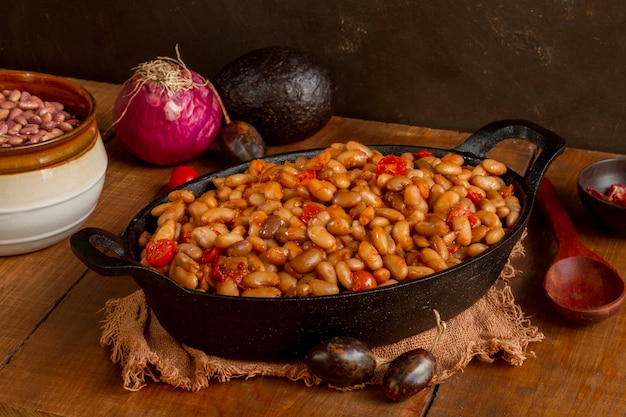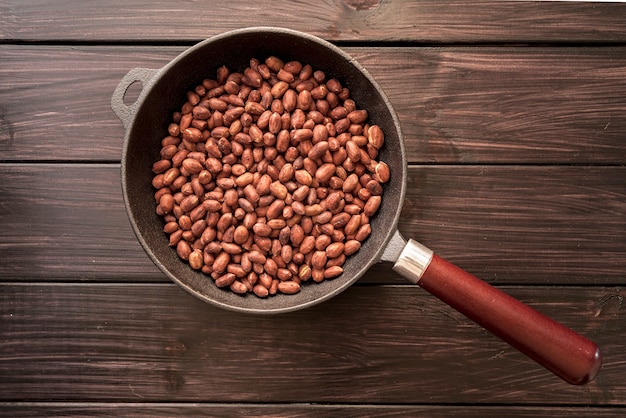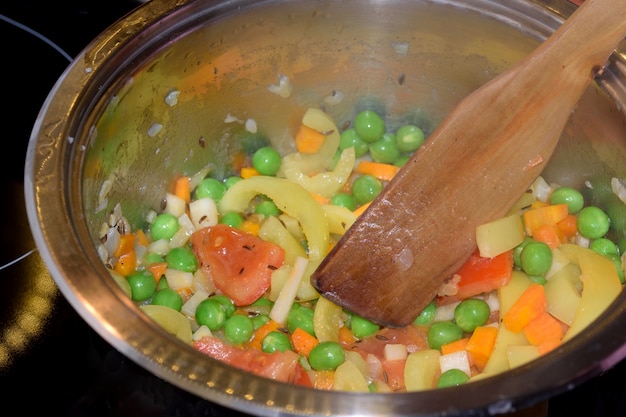Beans are a staple in my kitchen. They're versatile, budget-friendly, and incredibly satisfying. But for years, I struggled to cook them properly on the stovetop. Sometimes they were mushy, sometimes rock-hard, a culinary mystery that left me frustrated. Then, after much trial and error, I finally cracked the code. Now, I can confidently say that I'm a bean-cooking pro (at least in my own humble kitchen).
This guide is for everyone who wants to conquer the art of cooking perfect beans on the stovetop, whether you're a seasoned chef or a kitchen newbie. We'll cover everything from choosing the right beans to the best ways to cook them, with helpful tips, tricks, and even some of my own personal experiences sprinkled in. Let's get started!
(Part 1) Choosing the Right Beans

The first step to cooking perfect beans is choosing the right ones. It might seem simple, but there are so many varieties, each with its own unique flavour and texture. Think of it like choosing the right ingredient for your dish – you wouldn't use a delicate pea for a hearty stew, would you?
1.1 bean varieties
Here are some common bean varieties and their typical uses. I'll highlight my personal favourites, too, just to give you a taste of my own preferences:
- kidney beans: These are my go-to beans for chilli and other hearty dishes. They hold their shape well and have a slightly earthy flavour. I love them in a classic chilli con carne, simmered with smoky spices and a hint of chocolate.
- black beans: Black beans are another top choice for chilli, salsa, and dips. They have a rich, slightly sweet flavour and a firm texture. My favourite use for black beans is in a vibrant black bean salsa, where their earthy flavour balances beautifully with the sweetness of corn and the tang of lime.
- pinto beans: Pinto beans are a staple in Mexican cuisine. They have a creamy texture and a mild flavour that goes well with spices. I love them in a hearty vegetarian burrito bowl, piled high with rice, salsa, avocado, and fresh cilantro.
- cannellini beans: Cannellini beans are large and creamy, making them perfect for soups, stews, and salads. They have a delicate flavour that doesn't overpower other ingredients. I find them particularly delightful in a simple Italian bean soup, simmered with vegetables and a splash of good olive oil.
- butter beans: Butter beans are small and buttery, with a mild flavour. They're often used in salads and Mediterranean dishes. I love them in a summery Greek salad, tossed with tomatoes, cucumbers, olives, and feta cheese.
- Chickpeas: Chickpeas are a versatile legume that can be used in both sweet and savoury dishes. They're a great source of protein and fibre. I adore them in hummus, the creamy dip made with tahini, lemon juice, and garlic, and in falafel, those crispy, flavourful balls that are a Middle Eastern favourite.
1.2 Buying Beans
When buying beans, look for ones that are free from cracks, discolouration, and any signs of bugs. I always prefer buying dry beans over canned, as they have a better flavour and texture. However, canned beans are a great option if you're short on time or just want a quick and easy solution.
1.3 Storing Beans
Store dry beans in an airtight container in a cool, dry place. They can last for a year or more if stored properly. Canned beans should be stored in a cool, dark place and used within a year of the expiry date.
(Part 2) soaking beans

Soaking beans before cooking is essential for a few reasons. First, it helps to reduce the cooking time, saving you precious minutes in the kitchen. Second, it makes them easier to digest, preventing those unfortunate digestive discomforts. Third, it helps to remove some of the sugars that can cause gas, making them a more comfortable culinary experience.
There are two main methods for soaking beans:
2.1 Cold Soaking
This is the most common method of soaking beans. It involves simply placing the beans in a large bowl, covering them with cold water, and letting them sit overnight. I usually soak my beans for 8-12 hours, but you can soak them for up to 24 hours if you prefer. The key is to make sure the beans are completely submerged in water. I often add a pinch of salt to the soaking water, which helps to bring out the flavour of the beans.
2.2 Quick Soaking
If you don't have time for a cold soak, you can use the quick soaking method. This involves bringing the beans and water to a boil, then simmering them for 1-2 minutes. After that, remove them from the heat and let them sit for 1 hour. This method is great for those last-minute bean cravings, but it doesn't offer the same digestive benefits as cold soaking.
(Part 3) cooking beans

Now comes the fun part: actually cooking the beans! Here's my foolproof method for cooking perfect beans on the stovetop. It's simple, but a few key steps make all the difference.
3.1 The Basics
You'll need a large pot with a lid and a strainer. I use my trusty dutch oven for this – it's big enough to cook a good batch of beans and keeps them nice and warm. You can also use a large saucepan if you don't have a Dutch oven.
Here's what you'll need to do:
- Rinse the beans well under cold water, removing any debris or damaged beans. This ensures a clean and flavourful base for your bean dish.
- Place the beans in a large pot.
- Add enough water to cover the beans by at least 2 inches. The water should be at least an inch above the top of the beans.
- Bring the water to a boil, then reduce the heat to a simmer. This initial boil helps to ensure that the beans cook evenly.
- Add a teaspoon of salt. Adding salt too early can actually make the beans tough, so it's best to wait until they're almost cooked. The salt helps to season the beans and enhances their flavour.
- Cover the pot and simmer for the recommended time, depending on the type of beans you're using. Here's a handy table:
Bean Type Cooking Time (Soaked) Cooking Time (Unsoaked) Kidney Beans 45-60 minutes 1-1.5 hours Black Beans 45-60 minutes 1-1.5 hours Pinto Beans 45-60 minutes 1-1.5 hours Cannellini Beans 30-45 minutes 45-60 minutes Butter Beans 30-45 minutes 45-60 minutes Chickpeas 45-60 minutes 1-1.5 hours
3.2 Tips for Perfect Beans
Here are a few extra tips to ensure your beans turn out perfectly:
- Don't overcrowd the pot: Make sure there's enough space for the beans to move around and cook evenly. If the pot is too crowded, the beans may not cook evenly, resulting in some beans being undercooked while others are overcooked.
- Don't stir too much: Stirring the beans too often can break them down and make them mushy. Just stir them occasionally to ensure they're not sticking to the bottom of the pot.
- Check the beans regularly: Once they're almost cooked, taste them to see if they're tender enough. If they're still too firm, simmer for a few more minutes. You want the beans to be tender but not mushy.
- Add flavourings: Once the beans are cooked, you can add flavourings like garlic, onions, herbs, or spices. This is a great way to personalize your bean dish and add depth of flavour.
(Part 4) What To Do With Cooked Beans
Now you have a pot full of perfectly cooked beans – a culinary triumph! Let's explore some delicious ways to use them.
4.1 bean salads
A simple bean salad is a fantastic light lunch or side dish. Combine your cooked beans with chopped vegetables like tomatoes, cucumbers, bell peppers, red onion, and fresh herbs like parsley or cilantro. Add a vinaigrette dressing or a creamy tahini dressing for extra flavour. You can also add other ingredients like crumbled feta cheese, toasted nuts, or a squeeze of lemon juice.
4.2 Bean Soups and Stews
Beans are a natural addition to hearty soups and stews. They add protein, fibre, and a satisfying texture. I love to make a big pot of lentil soup with carrots, celery, and onions, simmered with a bay leaf and a touch of cumin. It's so warming and comforting on a cold day. You can also use beans in stews like a hearty vegetarian chili or a classic beef stew.
4.3 Bean Dips and Spreads
Beans make delicious dips and spreads. Try making a simple hummus with chickpeas, tahini, lemon juice, and garlic. It's a fantastic dip for crudités, bread, or crackers. You can also add other flavourings to your hummus, like roasted red pepper, sun-dried tomatoes, or a sprinkle of smoked paprika.
4.4 Bean Burgers
Who needs beef burgers when you can have bean burgers? They're packed with protein and fibre, and they're surprisingly delicious. Try mashing black beans with oats, breadcrumbs, and spices like cumin, chili powder, and garlic powder. Shape them into patties and grill or pan-fry them until golden brown. Enjoy them on a bun with your favourite toppings like lettuce, tomato, onion, and your favourite sauce.
(Part 5) Storing Cooked Beans
If you have leftover cooked beans, don't throw them away! They're perfect for using in other dishes later.
5.1 In the Fridge
Cooked beans can be stored in an airtight container in the refrigerator for up to 4 days. Just make sure they're completely cooled before putting them in the fridge.
5.2 In the Freezer
You can also freeze cooked beans for up to 3 months. Simply freeze them in an airtight container or freezer bag. To thaw them, transfer them from the freezer to the refrigerator overnight. You can also thaw them in a pot of boiling water for 10-15 minutes.
(Part 6) Troubleshooting
Sometimes, even with the best intentions, things can go wrong in the kitchen. Here are some common problems you might encounter when cooking beans and how to fix them:
6.1 Beans Are Too Mushy
This often happens if you cook the beans for too long. To prevent this, check them regularly and remove them from the heat as soon as they're tender.
6.2 Beans Are Too Hard
This happens if the beans weren't cooked long enough. Simply simmer them for a few more minutes until they're tender.
6.3 Beans Are Gassy
Beans are known for causing gas, but there are a few things you can do to reduce it. Soaking the beans before cooking is essential, and adding a pinch of baking soda to the cooking water can also help. However, it's important to note that baking soda can affect the texture and flavour of the beans.
6.4 Beans Are Foamy
Beans can produce foam when they're cooking. This is completely normal and doesn't affect the flavour or texture. You can skim off the foam with a spoon if it bothers you. However, it's usually best to leave the foam alone, as it will eventually dissipate.
(Part 7) Bean Variations
Let's get creative and explore some delicious bean variations:
7.1 Flavoured Beans
You can add flavour to your beans while they're cooking or after they're cooked. Here are some ideas:
- Herbs: Thyme, rosemary, sage, bay leaves, parsley, oregano, cilantro, dill
- Spices: Chili powder, cumin, paprika, garlic powder, onion powder, turmeric, smoked paprika
- Vegetables: Onions, garlic, carrots, celery, tomatoes, bell peppers, zucchini, leeks
- Smoked flavours: Smoked paprika, smoked salt, bacon, smoked ham hock
- Citrus: Lemon, lime, orange
7.2 Bean Dishes From Around the World
Beans are a staple in cuisines all over the world. Here are a few popular dishes to try:
- Chilli: This spicy, hearty stew is a favourite in many cultures. You can find countless variations of chili, from mild and vegetarian to fiery and meaty.
- Falafel: These crispy chickpea balls are popular in the Middle East and North Africa. They are often served in pita bread with hummus, tahini sauce, and fresh vegetables.
- Black Bean Salsa: A refreshing and flavourful salsa made with black beans, corn, tomatoes, onions, cilantro, and lime juice.
- Pasta e Fagioli: A comforting Italian soup made with pasta, beans, vegetables, and sometimes a bit of pancetta or bacon.
- Banh Mi: A Vietnamese sandwich filled with various ingredients, including pickled vegetables, cilantro, and often a generous helping of beans.
- Rajma Chawal: A popular North Indian dish made with kidney beans, onions, tomatoes, and spices.
(Part 8) Bean Health Benefits
Beans are not only delicious but also incredibly good for you. They're a great source of protein, fibre, and various vitamins and minerals.
8.1 Protein Powerhouse
Beans are a fantastic source of protein, making them an excellent choice for vegetarians and vegans. A cup of cooked beans can provide about 15 grams of protein, making them a great way to fuel your body.
8.2 Fibre Fantastic
Beans are high in fibre, which helps to keep you feeling full and satisfied. Fibre is also essential for digestive health, helping to regulate bowel movements and prevent constipation.
8.3 Packed with Nutrients
Beans are a good source of iron, potassium, magnesium, and folate. They also contain antioxidants that can help protect against disease.
(Part 9) FAQs
Let's address some frequently asked questions about cooking beans:
9.1 What if I Don't Soak the Beans?
You can skip soaking the beans, but it will increase the cooking time. Just add about 30 minutes to the cooking time listed above. However, soaking is generally recommended for better texture and digestibility.
9.2 Can I Use a pressure cooker to Cook Beans?
Yes, pressure cookers are a great way to cook beans quickly. Just follow the instructions for your specific pressure cooker. Pressure cookers can significantly reduce the cooking time for beans, making them a convenient option.
9.3 Can I Use Canned Beans Instead of dried beans?
Yes, you can absolutely use canned beans. Just drain and rinse them before using them in your recipes. Canned beans are a good option for a quick and easy meal.
9.4 How Do I Know When the Beans Are Done?
The beans should be tender but not mushy. You should be able to easily mash them with a fork. You can also taste the beans to see if they're cooked through.
9.5 How Long Can I Store Cooked Beans?
Cooked beans can be stored in an airtight container in the refrigerator for up to 4 days. You can also freeze them for up to 3 months.
I hope this ultimate guide to cooking perfect beans on the stovetop has been helpful. Now, go forth and conquer your bean cooking! Remember, with a little patience and the right technique, you can create delicious, satisfying bean dishes that will impress your family and friends. Enjoy!
Everyone is watching

Perfect Rice Every Time: The Ultimate Guide to Cooking Rice
Cooking TipsAs a self-proclaimed foodie, I've always been a bit obsessed with rice. It's the foundation of countless cuisi...

Prime Rib Roast Cooking Time Chart: Per Pound Guide
Cooking TipsPrime rib roast. Just the name conjures images of lavish dinners, crackling fires, and hearty laughter. It’s ...

The Ultimate Guide to Cooking Asparagus: Tips, Techniques, and Recipes
Cooking TipsAsparagus. The mere mention of this spring delicacy conjures up images of vibrant green spears, crisp and burs...

Ultimate Guide to Cooking the Perfect Thanksgiving Turkey
Cooking TipsThanksgiving. Just the word conjures up images of overflowing tables laden with delicious food, the scent of r...

How Long to Bake Potatoes in the Oven (Perfect Every Time)
Cooking TipsBaked potatoes are a staple in my kitchen. They're incredibly versatile, delicious, and surprisingly easy to m...
